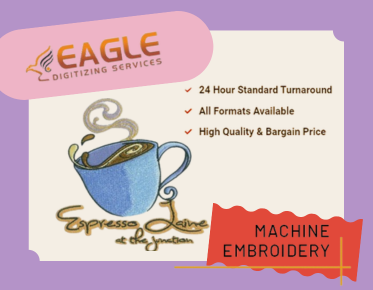How to Tell If a Digitized File Is High Quality – Tips from the Pros
In the world of embroidery, the quality of a digitized file can make or break the final product. Whether you're a seasoned professional or a newcomer to the industry, understanding what constitutes a high-quality digitized file is crucial. This guide will walk you through the key indicators of quality and provide insights from industry experts.
Understanding the Basics of Embroidery Digitizing
Embroidery digitizing is the process of converting artwork into a stitch file that can be read by an embroidery machine. This process requires precision and expertise to ensure that the final embroidered product meets the desired standards. Companies like Eagle Digitizing have honed their skills over decades, offering top-notch embroidery digitizing services that cater to a wide range of client needs.
Key Indicators of a High-Quality Digitized File
1. Stitch Density and Type
One of the primary indicators of a high-quality digitized file is the appropriate use of stitch density and type. The density should be balanced to avoid puckering or gaps in the fabric. Different stitch types, such as satin, fill, and run stitches, should be used appropriately to enhance the design's appearance and durability.
2. Pathing and Sequencing
Pathing refers to the order in which the stitches are laid down. A well-digitized file will have efficient pathing that minimizes thread breaks and reduces production time. Sequencing is equally important, as it ensures that the design is embroidered in a logical order, preventing unnecessary jumps and trims.
3. Compatibility with Embroidery Machines
A high-quality digitized file should be compatible with the specific embroidery machine being used. This includes ensuring the file format is correct and that the design is optimized for the machine's capabilities. Eagle Digitizing offers a variety of formats, including Tajima (DST), EMB, and EXP, to accommodate different machines.
Expert Tips for Evaluating Digitized Files
1. Conduct a Test Sew-Out
Before proceeding with a full production run, it's advisable to conduct a test sew-out. This allows you to evaluate the design's appearance and make any necessary adjustments. Companies like Eagle Digitizing provide sew-out images for custom designs, ensuring that clients can assess the quality before finalizing their orders.
2. Review the Design's Complexity
Complex designs require more intricate digitizing work. It's important to ensure that the digitized file accurately captures the details of the original artwork. Simplifying overly complex designs can help maintain quality and reduce production issues.
3. Seek Professional Assistance
If you're unsure about the quality of a digitized file, consider seeking professional assistance. Experienced digitizers can provide valuable insights and make necessary adjustments to enhance the design. Eagle Digitizing, for instance, offers revisions and format conversions to ensure complete client satisfaction.
The Role of Technology in Enhancing Quality
Advancements in technology have significantly improved the quality of digitized files. Modern digitizing software offers features like automatic pathing and stitch optimization, which help create more efficient and high-quality designs. Embracing these technologies can give your embroidery business a competitive edge.
Conclusion: The Future of Embroidery Digitizing
As the embroidery industry continues to evolve, the demand for high-quality digitized files will only increase. By understanding the key indicators of quality and leveraging professional services like those offered by Eagle Digitizing, businesses can ensure their products stand out in a competitive market. The future of embroidery digitizing looks promising, with ongoing innovations poised to enhance both the efficiency and quality of the digitizing process.



